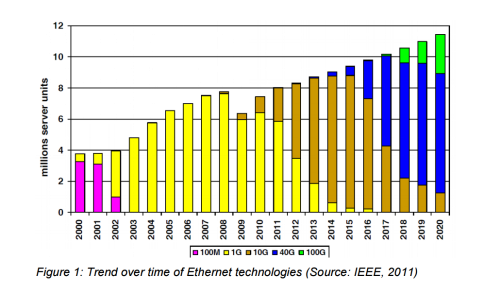In today’s server networks, 10GbE (Gigabit Ethernet) has become commonplace. However, for some workloads, 10GbE might not be enough. As data centers virtualize more of their servers and storage, the need for speedy network connections increases. Believe it or not, the 40GbE (Gigabit Ethernet) era is already upon us. The standard has long been ratified, and products are shipping. However, there has been some debate as to whether IT managers should hold off on deploying the 40GbE technology and bide their time waiting for 100GbE to become commercially available. Why should we choose 40GbE?
40GbE is an Ethernet standard developed by the IEEE 802.3ba Task Force that support sending Ethernet frames at 40 gigabits per second. It also addresses physical layer specifications for communication across backplanes, copper cabling, multi-mode fiber and single-mode fiber. At the heart of the 40GbE network layer is a pair of transceivers connected by a cable, for example OM4 or OM3 fiber cable. The transceivers, in turn, are plugged into either network servers or a variety of components including interface cards and switches. 40GbE is becoming commonly applied to access links to connect servers as Figure 1 indicates.

40GbE can be effectively deployed today in aggregation links in data center networks. The standards for 40 GbE have been around as a specification, and a number of routers, switches, and network cards already operate at this speed. Vendors such as Cisco, Dell’s Force10, Mellanox, HP, Extreme Networks, Finisar, and Brocade offer such hardware. And another attractive characteristic of 40GbE is broad applications and design flexibility. Considering the productivity gains and decrease in operating expense (OPEX), migrating to 40GbE will prove very cost-effective for those who do it right.
In migrating to 40GbE, some networks will be able to use their current 10GbE switch chassis and just upgrade their line cards and transceivers. Deploying a QSFP+ form factor transceiver will provide the flexibility to migrate from 10GbE to 40GbE. With regards to cabling, OM3 or OM4 is optimal for the 40GbE or 100GbE data center environment. The major difference is in the maximum span distances. In a 10GbE network, OM3 fiber can span up to 300m while OM4 supports even longer channels. In a 40GbE or 100GbE environment, OM3 can be used up to 100m and OM4 up to 150m according to the IEEE802.3ba standard. For applications approaching 150m, the cable should be terminated with low loss connectors.
It is like building an eight-lane superhighway with dirt off ramps and interchanges. Unless you upgrade everything, it is totally useless. You bump into things like immature network interface card drivers that can hang up your entire system. 40GbE is like a bridge which enbales you to prepare for higher needs. Fiberstore is a professional manufacturer and supplier of a complete range of 40GbE transceiver modules and cables. We provide compatible QSFP+ transceivers as alternatives to those branded by Cisco, HP, Juniper, Brocade, Finisar and so on. For example, Brocade QSFP+ and Finisar QSFP+ offer by us are high-performance and cost-effective products to fulfill your requirements.